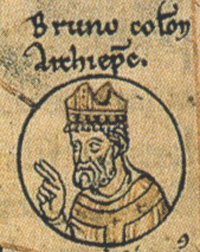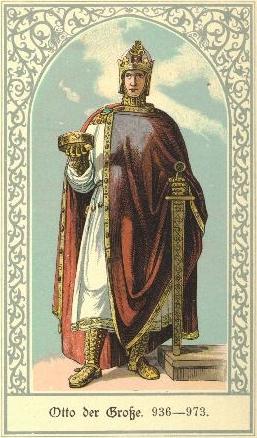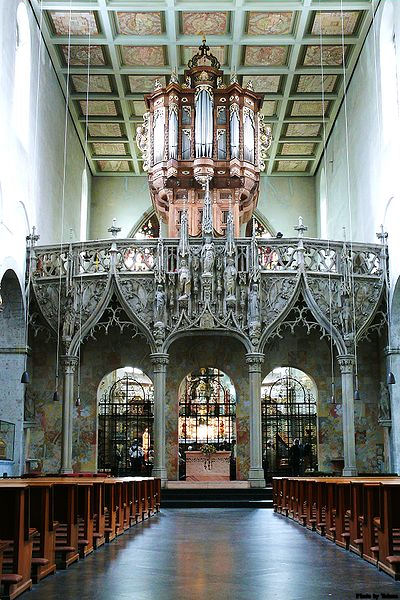St. Bruno the Great, Archbishop of Cologne
Bruno the Great (or Bruno I) (925–965) was Archbishop of Cologne, Germany, from 953 until his death, and Duke of Lotharingia from 954. He was the brother of Otto I, king of Germany and later Holy Roman Emperor. Bruno was the youngest son of Henry the Fowler and his second wife Matilda of Ringelheim.
In 940, Bruno began to exercise the functions of imperial chancellor (Mon. Germ. Dipl., I, 120 nr. 35). After he had received deacon’s orders in 941 or 942, the emperor appointed him, despite his youth, Abbot of the monasteries of Lorsch, near Worms, and of Corvei on the Weser. In both communities he soon restored the strict observance of St. Benedict’s Rule. He was ordained priest about 950 and in 951 became archchancellor (Mon. Germ. Dipl., I, 218, nr. 138 sq.); even from the year 940 on, all Otto’s state papers were prepared by Bruno’s hand.
As the executive administration of affairs was conducted chiefly through the royal chancery, Bruno’s influence now extended to all parts of the empire. Relations between Germany and France were by his good offices greatly improved. He took part in the Synod of Verdun, in 947, and assisted in the adjustment of the quarrel, of such consequence to the Kingdom of France, about the Archbishopric of Reims. In 951 he accompanied the Emperor Otto to Italy. In the troublesome times which soon followed during the revolt of Ludolf, Otto’s eldest son and heir-apparent, and Conrad, Duke of Lorraine, Bruno proved his loyalty and devotion to his brother. For this service, after the death (9 July, 953) of Wicfrid, Archbishop of Cologne, the emperor caused Bruno to be elected his successor in that see, and likewise entrusted to him the administration of the Duchy of Lorraine. On the 21st of September, the nobility of that province swore allegiance to Bruno at Aachen, and on the 25th he was consecrated and enthroned at Cologne. Through Bruno’s mediation Ludolf was reconciled with his father, and the rebellion of Conrad effectually quelled.
In the struggle between the last of the Carlovingians and the rising house of Capet, Bruno’s prestige enabled him to act, in the name of his imperial brother, as a supreme arbitrator in French affairs, countless disputes being satisfactorily settled by his prudence and tact.
In Bruno’s personality as prince-bishop was represented the perfect union of Church and State, which was the corner-stone of the policy of Otto the Great; for Bruno, despite his tireless temporal activities, was a great bishop and zealous pastor. He ruled by personal piety and singular holiness of life. With scrupulous care he watched over the moral discipline of his diocese, improved the higher education of the clergy and lavished his resources on monastic and ecclesiastical institutions throughout the realm. The monastery of St. Pantaleon at Cologne, begun in 956, was his foundation. The literary distinction to which Lorraine, before other parts of the kingdom, early attained may be accounted not the least remarkable result of his work. Bruno’s favourite abode was Bonn.
When Otto set out a second time for Italy in 961, to be crowned emperor at Rome, the government of the realm and the guardianship of Otto II was confided to Bruno and to William, Archbishop of Mainz. Soon after the kaiser’s return, Bruno was summoned again on a mission of peace to France; it was while on this journey that he died, at Reims. His body, at his own request, was carried back and buried in the monastic church of St. Pantaleon at Cologne. From time immemorial the Diocese of Tournay has had a special office for St. Bruno on June the 18th, and as the day of his death was always celebrated at St. Pantaleon as the anniversary of a saint, the feast of Bruno, Confessor, is now observed throughout the Diocese of Cologne as a double on the 11th day of October.

RUOTGER, Vita Brunonis in Acta SS., Oct., V, 698, also found in Mon. Germ. Hist., IV, 252, and in P. L., CXXXIV, 938; Altera Vita Brunonis (a later life, written in the 12th century at St. Pantaleon), in Mon. Germ. Hist., IV, 275; P. L., CXXXIV, 978; VON HEFELE, S.V. in Kirchenlex., II; HAUCK, Kirchengeschichte Deutschlands (Leipzig, 1896), III, 40; ID. in HERZOGHAUCK Real-Encyk. für prot. Theol. und Kirche (Leipzig, 1897); PIELER, Bruno I (Arnsberg, 1851); MEYER, De Brunone I (Berlin, 1870); PFEIFFER, Hist.-krit. Beiträge zur Geschichte Bruns I (Cologne, 1870); STREBITZKI, Quellenkr. Untersuch. (Neustadt in Westpreussen, 1875); GIESEBRECHT, Kaiserzeit (3d ed., Brunswick, 1863), I, 321; KÖPKE AND DÜMMLER, Kaiser Otto d. Gr. (Leipzig, 1876), passim; GIESEBRECHT, Allgemaeine Deutsche Biographie, III, 424; MITTAG, Die Arbeitsweise Ruotgers in der Vita Brunonis (Berlin, 1896); Analecta Bollandiana, XVI, 202 and XVIII, 57; WATTENBACH, Gesch.-Quellen (6th ed., Berlin, 1893), I, 321; KLEINERMANNS, Die Heiligen auf dem bischöflichen bezw. erzbischöflichen Stuhle von Köln (Cologne, 1895-98).
GEORGE H. DERRY (Catholic Encyclopedia)












